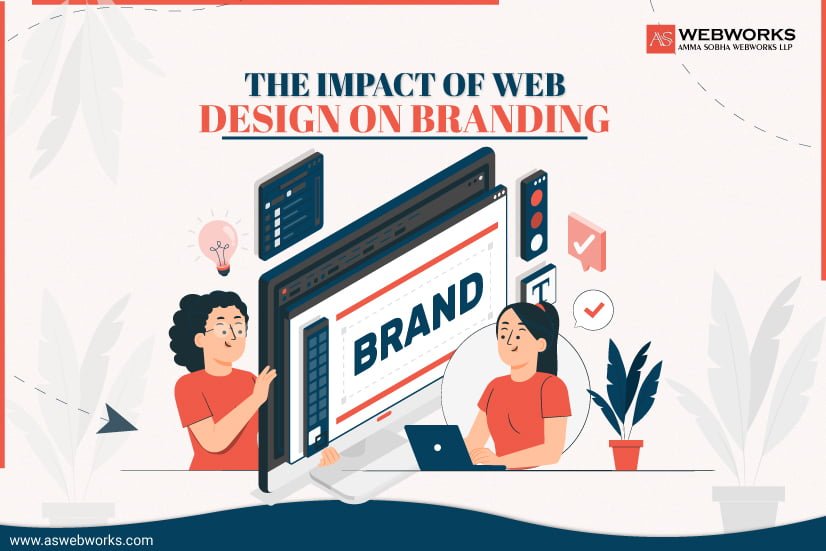The importance of site design extends beyond aesthetics in the fast-paced world of the digital landscape, where attention spans are short and first impressions are frequently formed in milliseconds. It is the unseen force that moulds a brand’s story and serves as a visual representative of personality, identity, and values to a worldwide audience. Welcome to a trip where the creativity behind the benefits of web designing on branding is revealed with every click, and pixels become storytellers.
We will traverse the complexities of the digital canvas in this investigation, revealing the significant impact that thoughtful web design has on the development, recognition, and longevity of a brand’s identity. Every component, from the tasteful colour scheme to the simple navigation that directs users’ experiences, adds to a digital tapestry that captures the spirit of a business and transcends mere aesthetics.

The Role of Branding In Website Design
From simple design, branding plays a crucial and complex role in website design, having a significant impact on user experience, reputation, and total online presence. The following summarizes the main ideas of benefits of the best web design company.
-
Creating a Visual Identity:
At its foundation, branding is the process of developing a distinctive and identifiable visual identity. This identity is expressed through the design of websites. The personality and values of the brand are visually communicated through the purposeful incorporation of elements like logos, colour schemes, and typography.
-
Consistency Across Platforms:
The website is an essential component of this continuum, which is necessary for a consistent brand image across all touchpoints. Ensuring users receive consistent design elements, messaging, and images.
-
User Experience (UX):
A website’s user experience is greatly impacted by branding. In addition to making sure that the website is easy for consumers to browse, the design should visually represent the business. A brand-value-aligned, well-designed website enhances user experience and encourages engagement and loyalty.
-
Communicating Brand Values and Storytelling:
Website design is a storytelling tool that goes beyond aesthetics. A website may effectively communicate the values and narrative of a brand through its layout, content, and graphics. The website’s design elements should enable users to comprehend the brand story and establish a connection with its objective.
-
Developing Trust And Trustworthiness:
A well-designed website raises a brand’s trustworthiness. A well-designed and aesthetically pleasing website conveys expertise and meticulousness. Website design is essential to establishing and preserving user trust since consumers are more likely to believe in a company that makes an investment in a professional online presence.
-
Differentiation And Innovation:
Making an impression is crucial in the cutthroat online world. The benefits of web designing is gives brands the chance to set themselves apart with creative and unique design decisions. A distinctive and unforgettable website makes a brand stand out and helps with memory and recognition.
Defining Branding And Website Design
The interaction between branding and website design is essential in the digital age to produce an engaging and unified online presence. To grasp their unique essences and how their synergy creates the cornerstone of a potent digital identity, let’s break down the definitions of branding and website design.
-
Defining Branding; Not Just About Colors And Logos:
Branding is much more than just visual components like colour schemes and logos; it is the comprehensive portrayal of a company. It captures the core of an organization, including:
-
Brand Identity Distinguishes The Visual Components Of A Brand:
Brand personality refers to the human qualities and attributes that define a brand and influence its perception. Is the brand trustworthy, inventive, or personable? Brand messaging is the vocabulary and tone that are used to interact with the public, making sure that all channels of communication are consistent and resonate.
-
Brand Experience:
A consumer’s total brand experience is shaped by all of their interactions with the brand, both online and offline.
-
Defining Web Design:
An Illustrative and Useful Guide The art and science of developing a website’s aesthetically pleasing and useful interface, on the other hand, is known as website design. It includes in the benefits of web desining.
-
Visual Components:
Using design components, logos, and brand colours to produce a visually unified image of the brand is the benefits of web desining.
-
User Experience (UX):
Making sure that every aspect of the website, from navigation to interaction, is easy for users to understand and enjoy. The process of adapting a website’s functionality and layout to various devices in order to provide consumers with a consistent and ideal experience across desktop, tablet, and mobile platforms is known as responsive design. Information architecture is the process of arranging and arranging content so that people can easily find what they’re looking for.
-
Memorability:
Creating an online presence that is memorable and sticks in users’ minds, promoting brand recall.
Regular Brand Audits And Updates

-
Adaptability To Market Dynamics:
Businesses may remain flexible in the face of changing market dynamics by conducting regular brand audits. Brands may effectively capture opportunities and handle problems by adapting their strategy to reflect ongoing consumer trends, industry transformations, and competitive landscapes.
-
A Coherent And Consistent Brand Identity:
It’s important to maintain brand coherence across a variety of touchpoints. Businesses make sure that their visual components, messaging, and values are still in line by conducting frequent audits. A cohesive brand identity strengthens the audience’s perception of the brand’s authenticity by promoting trust, recognition, and loyalty.
-
Differentiation For Competitive Edge:
It’s critical to stand out in a crowded market. Frequent brand audits aid in discovering points of differentiation. Businesses may innovate, stay relevant, and carve out a unique niche by deliberately updating elements.
-
Future-Proofing And Resilience:
Brand audits concentrate on future-proofing the brand, looking beyond the here and now. Businesses are able to alter their brand strategies proactively by anticipating trends and future issues. This innovative strategy guarantees adaptability and sets up the brand for long-term success in a constantly shifting business landscape.
To put it simply, the combination of frequent brand audits and updates gives companies the ability to actively shape their brand for long-term success in the ever-changing marketplace, in addition to being current.
Future-Proofing The Brand:
Anticipating Trends and Challenges A brand audit is not only about the here and now but also about planning for the future. Businesses can strategically update their brand to be resilient and future-proof by assessing industry trends and foreseeing potential obstacles. This forward-thinking approach positions the brand for sustained success.
Establishing Trust via Professionalism:
Reliability is Reflected in design as a means of communicating professionalism. A well-designed website exudes competence and dependability, winning over visitors’ trust. Professional site design, as the brand’s digital face, reassures visitors that they are interacting with a reliable and respectable organization.
Conclusion
As we approach the end of this investigation, it is clear that branding and web design go hand in hand. Every design decision is a calculated risk that offers the chance to influence how the public views and interacts with a brand. The benefits of web designing bring together usefulness and aesthetics to produce a compelling brand experience that sticks with users long after they click. Pixels have the transforming ability to take a brand from just being visible to having a memorable online presence. In the digital age, web design serves as the architectural plan for exceptional branding, not merely a decorative item.

